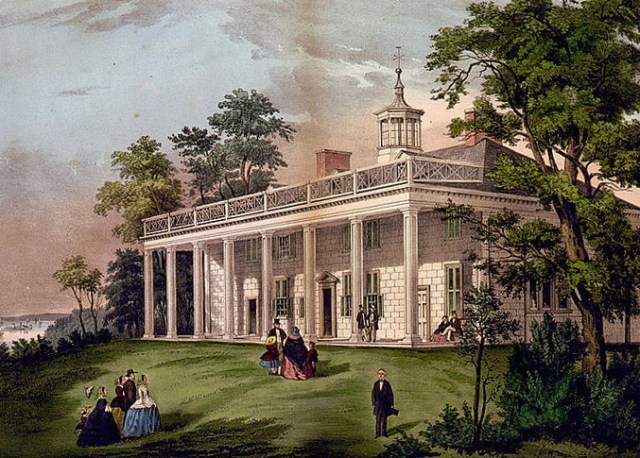
Here are some sketches of the houses of the founding fathers. George Washington’s Mount Vernon occupies, of course, pride of place. Benjamin Franklin’s house does not remain, alas, not unlike houses of some of the other founders, but at least Franklin’s memory was not besmirched by the sort of abomination that “represents” Franklin Court, in Philadelphia. As I could not find an image of Samuel Adams’s own house, I used the house he was hiding in at Lexington when the British were coming.

Thomas Jefferson’s Monticello, drawn in 1803 by Robert Mills. (pinterest.com)

John Adams’s house in Quincy, Mass. (famousamericans.net)

John Madison’s Montpelier, near Orange, Va. (etc.usf.edu)

House of Jonas Clark, hideout of Samuel Adams, in Lexington, Mass. (paulreversriderevisited.wordpress.com)

Alexander Hamilton’s Hamilton Grange. (uptownflavor.wordpress.com)

John Jay’s Bedford House, in Bedford, N.Y. (famousamericans.net)

John Hancock’s house. (freepages.history.rootsweb.ancestry.com)

Fairmont Water Works, built 1812-72, near Philadelphia Museum of Art. (halifaxbloggers.ca)
Not even HABS has an old image of Franklin Place. So, unable to bring myself to conclude this retrospective with the modernist kitsch of Venturi & Rauch inflicted upon historic Philadelphia in 1976, I offer the Fairmont Water Works. Glimpsing it briefly but frequently from Amtrak, I’d always believed to be college crew boathouses, they were designed in 1809 and built in 1812-72 to disguise the pump equipment of the city’s former water system, atop the reservoir for which the museum now sits.

About David Brussat
This blog was begun in 2009 as a feature of the Providence Journal, where I was on the editorial board and wrote a weekly column of architecture criticism for three decades. Architecture Here and There fights the style wars for classical architecture and against modern architecture, no holds barred.
History Press asked me to write and in August 2017 published my first book, "Lost Providence." I am now writing my second book.
My freelance writing on architecture and other topics addresses issues of design and culture locally and globally.
I am a member of the board of the New England chapter of the Institute of Classical Architecture & Art, which bestowed an Arthur Ross Award on me in 2002.
I work from Providence, R.I., where I live with my wife Victoria, my son Billy and our cat Gato.
If you would like to employ my writing and editing to improve your work, please email me at my consultancy, dbrussat@gmail.com, or call 401.351.0457.
Testimonial: "Your work is so wonderful - you now enter my mind and write what I
would have written."
- Nikos Salingaros, mathematician at the University of Texas, architectural theorist and author of many books.












like….
LikeLike
Nice collection. Alexander Hamilton?
Bill *Carroll William Westfall* Professor Emeritus School of Architecture University of Notre Dame
LikeLike
Hah! Thanks, Bill! Guess I got tangled up in all the Johns. Bless you.
David
LikeLike